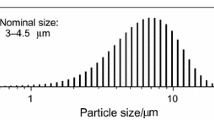Abstract
Validation of the Cabrera-Mott low-temperature oxidation model is proposed to better establish a procedure for the passivation of aluminum nanoparticles after production. The powder, generated in an inductively coupled plasma reactor and characterized by a specific surface of around 40 m2/g, is sampled prior to passivation. Controlled oxidation of the powder is then performed in a TGA/DSC apparatus using different oxygen concentrations. The mass increase due to the oxidation of aluminum to amorphous alumina is mathematically converted into an oxide thickness evolution. The experimental results are then compared with the Cabrera-Mott model and the values of parameters such as the distance between energy barriers, the number of ions per unit area, and the Mott potential are set. In addition, the latter two parameters are varied with the oxygen concentration, following an evolution similar to that of a Langmuir isotherm. This paper then proposes the first validation of a low-temperature oxidation model for aluminum nanoparticles.











Similar content being viewed by others
Abbreviations
- TGA:
-
thermogravimetric analysis
- DSC:
-
differential scanning calorimetry
- EEW:
-
electron explosion wire
- TEM:
-
transmission electron microscopy
- EDX:
-
energy dispersive x-ray spectroscopy
- BET:
-
Brunauer–Emmett–Teller
References
Cabrera N, Mott N (1949) Theory of the oxidation of metals. Rep. Prog. Phys. 12:163–184
Cai N, Zhou G, Muller K, Starr DE (2011) Tuning the limiting thickness of a thin oxide layer on Al(111) with oxygen gas pressure. Phys Rev Lett 107(3):035502
Christmann K (1991) Introduction to surface physical chemistry. In: As part of topics in physical chemistry (vol 1). Springer Verlag Berlin, Heidelberg Gmbh. https://www.springer.com/gp/book/9783798508583
Ermoline A, Dreizin EL (2011) Equations for the Cabrera-Mott kinetics of oxidation for spherical nanoparticles. Chem Phys Lett 505:47–50
Jeurgens L, Sloof W, Tichelaar F, Mittemeijer E (2002) Growth kinetics and mechanisms of aluminum-oxide films formed by thermal oxidation of aluminum. J Appl Phys 92(3):1649–1656
Laboureur D, Glabeke G, Gouriet J (2019) Aluminum nanoparticles oxidation by TGA/DSC: parametric analysis and oxide thickness determination. J Therm Anal Calorim 137(4):1199–1210
Lopes S, Proulx P, Gouriet J-B, Rambaud P (2013) Application of an integrated CFD model to aluminium nanoparticle production, In :15th International Heat Transfer Conference
Martin M, Fromm E (1997) Low-temperature oxidation of metal surfaces. J Alloys Compd 258:7–16
Martirosyan K, Ramazanova Z, Zyskin M (2014) Self-heating model of spherical aluminum nanoparticle oxidation. Eurasian Chemico-Technol J 16:11–15
Pesiri D, Aumann C, Bilger L, Booth D, Carpenter R, Dye R, Neill O, Shelton D, Walter K (2004) Industrial scale nano-aluminum powder manufacturing. J Pyrotech 19:19–31
Phung X, Groza J, Stach E, WIlliams L, Ritchey S (2003) Surface characterization of metal nanoparticles. Mater Sci Eng A 359:261–268
Sundaram DS, Puri P, Yang V (2013) Pyrophoricity of nascent and passivated aluminum particles at nano-scales. Combust Flame 160(9):1870–1875
Trunov M, Schoenitz M, Dreizin E (2006) Effect of polymorphic phase transformations in alumina layer onignition of aluminium particles. Combust Theory Model 10(4):603–623
Vorozhtsov A, Lerner M, Rodkevich N, Nie H, Abraham A, Schoenitz M, Dreizin E (2016) Oxidation of nano-sized aluminum powders. Thermochim Acta 636:48–56
Acknowledgements
The authors would like to thank the Walloon Region for financial support under convention 7364, KULeuven University for the TEM measurements, and Nanopole S.A. for the nanopowder and the BET measurements.
Funding
This work was funded by the Walloon Region under convention 7364.
Author information
Authors and Affiliations
Contributions
All authors contributed to the study conception and design. The collection of aluminum nanoparticles together with the TGA/DSC testing was performed by G. Glabeke. The post-processing and analysis of the results as well as the model implementation and validation were performed by D. Laboureur. The first draft of the manuscript was written by D. Laboureur and all authors commented on previous versions of the manuscript. All authors read and approved the final manuscript.
Corresponding author
Ethics declarations
Conflict of interest
The authors declare no competing interests.
Additional information
Publisher’s note
Springer Nature remains neutral with regard to jurisdictional claims in published maps and institutional affiliations.
Rights and permissions
About this article
Cite this article
Laboureur, D., Glabeke, G. & Gouriet, JB. Validation of Cabrera-Mott model for low-temperature oxidation of aluminum nanoparticles. J Nanopart Res 23, 71 (2021). https://doi.org/10.1007/s11051-021-05170-z
Received:
Accepted:
Published:
DOI: https://doi.org/10.1007/s11051-021-05170-z




